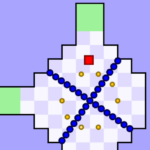Kamisama Kiss, known in Japanese as Kamisama Hajimemashita, is a beloved shojo manga and anime series that has captivated fans worldwide with its unique blend of romance, supernatural elements, and character development. Created by Julietta Suzuki, this enchanting story not only entertains but also subtly challenges traditional gender roles in anime, offering a fresh perspective on character dynamics and relationships.
The Premise of Kamisama Kiss
Kamisama Kiss follows the journey of Nanami Momozono, a high school student who becomes a land god after a chance encounter with Mikage, the former deity of a local shrine. As Nanami adjusts to her new divine responsibilities, she forms a contract with Tomoe, a fox yokai who serves as the shrine’s familiar. Their relationship forms the core of the story, evolving from initial antagonism to a deep, complex bond that defies conventional expectations.
Subverting Gender Stereotypes
One of the most striking aspects of kamisamakiss.com is how it challenges traditional gender roles in anime. This is evident in several key ways:
Nanami’s Character Development
Nanami, the protagonist, begins as a seemingly typical shojo heroine – kind-hearted, optimistic, and somewhat naive. However, as the story progresses, she demonstrates remarkable growth and strength. Unlike many female leads in shojo anime who remain passive or rely heavily on male characters for protection, Nanami actively works to improve her abilities as a land god. She faces challenges head-on, makes difficult decisions, and often saves her companions, including Tomoe, from danger.
Tomoe’s Complex Masculinity
Tomoe, the male lead, subverts typical masculine stereotypes in anime. While he possesses immense power and a fierce protective streak, he also displays vulnerability, emotional depth, and a capacity for growth. His initial resistance to serving Nanami gradually gives way to respect and affection, challenging the notion that strong male characters must always maintain emotional distance or dominance.
Reversing Power Dynamics
Kamisama Kiss presents a unique power dynamic between its main characters that further challenges traditional gender roles in anime:
Nanami as the Authority Figure
As the land god, Nanami holds a position of authority over Tomoe, her familiar. This reversal of the typical male-dominant hierarchy in many anime series allows for interesting explorations of power, responsibility, and mutual respect. Nanami’s growth into her role as a deity parallels her journey of self-discovery and empowerment.
Balanced Partnership
Despite the initial master-servant dynamic, Nanami and Tomoe’s relationship evolves into a balanced partnership. They support each other’s strengths and compensate for each other’s weaknesses, demonstrating that true strength lies in cooperation rather than domination.
Breaking Romantic Tropes
Kamisama Kiss also challenges conventional romantic tropes often found in shojo anime:
1. Gradual Romance: Unlike many series where love blossoms quickly, the romantic relationship between Nanami and Tomoe develops slowly and organically. This pacing allows for deeper character development and a more realistic portrayal of emotional growth.
2. Mutual Growth: Both Nanami and Tomoe undergo significant character development throughout the series. Their individual growth contributes to the strength of their relationship, emphasizing the importance of personal development alongside romantic pursuits.
3. Emotional Vulnerability: The series portrays both male and female characters experiencing and expressing a wide range of emotions. This balanced approach challenges the stereotype that emotional expression is primarily a feminine trait in anime.
Supporting Characters and Gender Representation
Kamisama Kiss extends its challenge to traditional gender roles beyond its main characters:
1. Diverse Female Characters: The series presents a variety of female characters with different personalities, strengths, and goals. From the determined Himemiko to the powerful Narukami, these characters defy the one-dimensional portrayals often seen in anime.
2. Nuanced Male Characters: Male supporting characters like Mizuki and Kurama also exhibit complexity, showing that men can be nurturing, emotionally expressive, or even flawed without losing their appeal or strength.
3. Gender-Fluid Representation: Characters like Otohiko, who presents with both masculine and feminine traits, add another layer to the series’ exploration of gender roles and identity.
Cultural Context and Impact
Kamisama Kiss’s approach to gender roles is particularly significant when considered within the context of Japanese culture and the anime industry:
1. Challenging Traditions: By presenting strong, multifaceted female characters and emotionally complex male characters, the series subtly challenges traditional Japanese gender expectations.
2. Industry Influence: As a popular shojo series, Kamisama Kiss has the potential to influence other creators and contribute to a broader shift in how gender roles are portrayed in anime and manga.
3. Global Appeal: The series’ nuanced approach to gender and relationships has resonated with international audiences, highlighting a growing demand for more diverse and balanced representations in anime.
Conclusion
Read Kamisama Kiss Manga Free Online stands out as a shining example of how anime can challenge traditional gender roles while still delivering an engaging, romantic story. Through its well-developed characters, balanced relationships, and nuanced exploration of power dynamics, the series offers a fresh perspective on familiar tropes. It demonstrates that strength comes in many forms and that true partnerships are built on mutual respect and growth.
As the anime industry continues to evolve, series like Kamisama Kiss pave the way for more diverse and inclusive storytelling. They remind us that challenging gender stereotypes not only creates more interesting narratives but also resonates with a wide audience seeking representation and depth in their entertainment.
Have you experienced how Kamisama Kiss challenges traditional gender roles in anime? We’d love to hear your thoughts and observations on how this beloved series has impacted your perspective on gender representation in anime and manga. Share your experiences in the comments below!


































